We’ve all been there – standing at the gas station, squeezing that nozzle handle, patiently waiting as fuel rushes into the tank. But have you ever stopped to think about the remarkably complex process and pipeline that gasoline travels before even reaching your grasp? Tracking the path of fuel from underground storage all the way […]
We’ve all been there – standing at the gas station, squeezing that nozzle handle, patiently waiting as fuel rushes into the tank. But have you ever stopped to think about the remarkably complex process and pipeline that gasoline travels before even reaching your grasp? Tracking the path of fuel from underground storage all the way to that nozzle is pretty fascinating.
Here’s a detailed overview explaining the journey of fuel to the nozzle:
Your local gas station has one or more giant tanks buried beneath the concrete, out of sight. These underground reservoirs can hold thousands upon thousands of gallons of gasoline. Typically constructed from double-walled fiberglass or steel for safety and leak prevention, the tanks act as the starting point for fuel’s journey to your vehicle.
Those underground storage tanks connect to the fuel dispensers you see on the concrete island through an intricate network of turbine piping and hoses. The pipes run underneath the concrete forecourt before rising up into each dispenser unit. This pipeline carries the fuel’s entire flow from its underground reservoir to the actual gas pump you’ll be operating.
Each gas dispenser has its own pumping unit integrated inside. This pump generates the vacuum pressure and flow that literally sucks gasoline up from the underground storage tank below. When you squeeze the nozzle handle, you’re activating this pumping mechanism to push fuel through the hose and out the nozzle spout into your car.
Most pumps operate around 40 PSI of positive pushing pressure. This allows them to shove fuel vertically up from the underground tank’s depth and out to the nozzle at sufficient speed for convenient refueling. The pumps are the real muscle, making it all possible.
At higher-end or more environmentally-conscious gas stations, the fuel dispensers incorporate vapor recovery systems as well. As gasoline rushes from the underground tanks, it releases vapors that can pollute outdoor air quality.
The vapor recovery equipment captures those gasoline fumes and pipes them back down into the underground storage tanks instead of venting them into the atmosphere.
After that full underground-to-pump journey, the fuel’s last step is traveling through the reinforced rubber hose to the nozzle itself. This rubber hose connects the pump unit to that final handheld nozzle you’ll be operating. The nozzle’s internal delivery pathway is even narrower, accelerating flow out the spout for smooth dispensing into your tank’s filler neck.
So next time you’re gripping that fuel nozzle and squeezing the handle, appreciate just how remarkable that little device’s connection to your car really is. The gasoline has traveled an impressive distance through a vast safety-focused piping network from subterranean storage tanks all the way into your grasp.
At AOCHENG Group, we understand the intricacies of this process and are dedicated to providing top-quality fuel nozzles, fuel hose reels, and fuel transfer tanks for agricultural and industrial use. Trust AOCHENG for reliable equipment that ensures seamless operations every time.




